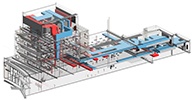There are several professional practice trends currently maturing within the Architecture/Engineering/Construction (AEC) industry: Sustainable Design, LEAN Construction, Integrated Contracts and Energy Efficient Facilities Management.

One of the most significant results from our collective work toward these valuable efforts will no doubt be to effectively develop a new system of norms for standards and rules based on triple bottom line business principles, which will be used within our services and projects for the next generation to come.
Regardless of our roles in lifecycle of a healthcare facility, level of comfort or experience with these trends, I am confident you will agree that accomplishing our many related subjective aims and objective goals inevitably requires careful consideration of two fundamental concepts:
- Stakeholder information exchanges act as a communication medium
- Facilities information packages act as primary messages

We also have the opportunity to help responsibly prioritize the next wave of trends as well. Biomimicry Design, Offsite Fabrication and Integrated Workplace Occupancy are just a few trends we might positively effect.
These two concepts are worth special attention due to the following factors:
- A reliable multi-discipline plan of co-authorship requires more than coordination of tasks and cooperation of schedules.
- Repeatable interpretation method of formatting facility data, preferences and intelligence requires more than software procedures and instructions.
I have enjoyed serving in various capacities in private, public and government corporations, and can honestly share from personal experience that we can enable all of above trends by implementing smart techniques and off-shelf tools related to building information model management (BIM).
I invite you to be open to adopting a personal belief that BIM is a mission critical ‘trend enabler’ rather than assuming BIM is a ‘trend’ unto itself. This subtle, but important distinction is indeed a bearable, equitable and viable approach. Perhaps you have example you can share illustrating how it is a healthy course of action to consider BIM as an enabler, not as trend, from your own professional practice. I welcome your comments. I also encourage you to read more of my thoughts on facility informatics by clicking the link below to Array Architects’ blog.

